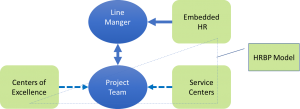Human Resource Functional Transformation
Re-alignment of Human Resource Departments from transactional to the transformational has been taking place for the last 20 years. In the past, HR departments were more of a support organization. Many Senior Managers and Executives believed that Human Resource Departments should be more strategic in helping the organization achieve its business goals.
From Generalist to Human Resource Business Partner
A typical Human Resource Manager or a Generalist worked in areas of training, recruiting, payroll, and performance reviews. Each of these roles supported the entire organization. Organizations hired outside consultants to work strategic tasks with line and executive management. Line and executive management gave HR their human capital requirements and the functional organizations filled the requests.
HR Executives believed that the right HR individual could do the strategic work of the consultant. HR Managers have the overall knowledge of HR processes and execution. However, to meet the roles necessary for the transformation from transactional to transformational HR managers and specialists required additional skills.
An essential component of the transformational strategy was the development of the Human Resource Business Partner (HRBP) Model. In this model, an HR Manager moved away from performing transactional tasks to more of a transformational role. For this role the HR Manager needed to add the skills necessary to support the Business Manager in a strategic capacity.
Business Partner Structure
The transformational structure that supports the business partner concept includes three distinct functions (three-point triangle). They are Service Centers, Centers of Excellence, and Embedded HR. The HRPB’s  reside in the embedded HR function. It is embedded in that the HRBP and support staff are located with the project team reporting to the line manager. Embedded HR no longer reports to the HR director. The HRPBs act like consultants however unlike consultants they have the power to make changes. Service centers provide the line managers with transactional services such as payroll, onboarding, benefits, and training. Centers of excellence provide the expertise to develop and deliver training, maintain and improve processes. An optional function, Operational Executors, provide executing support to the HRBP to allow the HRBP to remain in a strategic role. Some organizations combine the centers of excellence and service centers. Others outsource the service centers.
reside in the embedded HR function. It is embedded in that the HRBP and support staff are located with the project team reporting to the line manager. Embedded HR no longer reports to the HR director. The HRPBs act like consultants however unlike consultants they have the power to make changes. Service centers provide the line managers with transactional services such as payroll, onboarding, benefits, and training. Centers of excellence provide the expertise to develop and deliver training, maintain and improve processes. An optional function, Operational Executors, provide executing support to the HRBP to allow the HRBP to remain in a strategic role. Some organizations combine the centers of excellence and service centers. Others outsource the service centers.
Implementation Issues
This transformation was not without its issues. Transforming HR managers into the new strategic role resulted in gaps in training, expectations, and overall confusion as to the competencies necessary for the position. These issues were universal in attempts to transform HR.
Common Issues with Implementation
A review of 12 studies that looked at over 150 organizations spanning 20 years provided a common theme of issues in the implementation of the HRBP model.
- Boundary Issues: trouble in differentiating between old and new roles
- Gaps in Service: roles and responsibility issues caused tasks to fall through the cracks.
- Centers of Expertise Communication Difficulties with other Functions: Unclear reporting structure
- Difficulty in separating out transactional work: Speaks to boundary issues and gaps in service. Lack of clear assignment of accountability.
Boundary issues were by far the most common problem. The roles and responsibilities were new and unproven. Line managers were accustomed to directing individuals to meet their requirements. This caused confusion. As an example, when a line manager demanded that the HRBP work transactional rather than transformational tasks it impeded the HRBP’s strategic focus. Gaps in service were a result of an unclear understanding of what new function performed what tasks. For example, administration function believed that the embedded services performed payroll. Communication difficulties were caused mainly by the silo effect. Difficulty in separating out transactional work is another result of unclear areas of responsibility.
Solutions to Implementation Issues
Several organizations in the study provided proven solutions to many of these problems.
To solve the boundary and communication issues, Vodafone’s solution was to implement a workshop program. All 30 HRBPs took part in the workshops along with senior line management. They followed up the training program with management support for the transition, monthly learning days, performance dialogs and keeping the new structure at the forefront of company communications. In 12 months, they experienced a significant step change in performance. They met their goal of high value lower cost.
American Express, established a phased approach to implementation. This approach included communication from the CEO to all employees indicating the reasons for and the impending changes. This communication was followed by training high-level managers about the changes and providing talking points and training materials to enable them to discuss the changes.
Lawson Products implemented a business strategy approach by assigning business people who specialize in HR. Training of these individuals and line management occurred before the transformation occurred.
Best Practice Solutions to Reduce Implementation Issues
Essential to avoiding implementation issues lie in basic organizational development change management. For the three-point structure to be effective, there must be an alignment of HR organization with the business structure and goals of the organization. HR and Line management should be involved in the planning and execution of the change. Upper Management must be a visible and active participant of the implementation.
Matthew Brearley, Vodafone UK’s head HR business partner provided insight into their successful transition to the HRBP model in his paper “Making the HR business partner transition at Vodafone.” Vodafone’s goal was to transform HR into a high value, lower-cost operating model. The main issue facing the implementation was the “I understand that I am not going to be doing the transactional stuff, but I am not 100% sure of what I am supposed to do” from managers thrust into the HRBP role. The establishment of workshops and follow up training provided what they were “supposed” to do.
Summary
Implementation of the HRBP model takes place more often than any other transformation. The benefits are positive for the organizations that implement the partnership correctly. Best practices for a successful implementation are:
- Align the HRBP with the business objectives of the line units.
- Ensure that the HRPB’s have the skills to perform the tasks.
- Clearly establish the roles and responsibilities of all involved functions
- Establish a reliable transactional capability to allow the HRBP to perform strategically.










